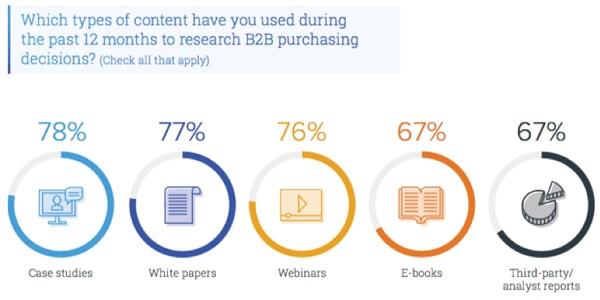
Traditionally, a company’s marketing team is separate from its sales team.
However, in the modern business world, those lines are starting to get blurred, and integration now seems to be the name of the game.
This doesn’t mean that you should merge marketing and sales; rather, it means that you can use strategies from one to help the other.
In marketing, nothing is more important than content. However, did you know that you can use B2B content marketing to make the customer journey more effective?
Integrating content into the sales process is one way to target the right prospects, avoid missed opportunities, increase conversion rates, and improve retention.
Good content is vital in not only making the customer's journey better and more effective, but saving your team time and energy while bringing in more sales.
Three benefits of good content include:
It's obvious that there are many benefits to incorporating content into your sales. However, this integration doesn't just happen without a strategy. In order to achieve the these benefits, there are five steps to follow to integrate content into your sales process.
Before you create content, you need to have a particular end goal in mind. What are you trying to achieve? Is it more leads? More sales? Brand awareness?
No matter what your key performance indicators (KPIs) are, it’s important that you clearly define them. If you know what success looks like to you, it will help you create purpose-driven content that actually makes an impact and encourages prospects to take the action you want them to.
Customers are more intelligent and sophisticated now, and your content needs to reflect that. You can’t rely on hard sell tactics alone.
Winning content is usually educational content that provides value, making customers want to buy into what you’re selling. What kind of content does your audience want? What are their fears, concerns, frequently asked questions during the sales process? How can you establish your authority in your particular niche?
Always match your sales content with particular stages in the customer journey, targeting a specific persona. You can create in-depth guides, how-to blog posts, eBooks, webinars, infographics, videos, and more, depending on where they are in the sales funnel.
 Source: Demand Gen Content Preferences Study
Source: Demand Gen Content Preferences Study
Remember the four steps of inbound marketing when creating your content:
Be careful about over-saturating or overwhelming your audience with too much information too fast. Cut them up into short, digestible content bits; it’s easier to understand, and you’ll have much more content on your site. It’s a win-win. Ensuring you have an efficient content production process is vital, this could make or break the whole process.
Do you know who is in the best place to create impactful, effective content for your prospects? Your sales team.
They have real experience with your customers and the best insight on them as well. So use them to get feedback on what topics you should cover, what language your customers respond to, and what they really want to know about your brand. Better yet, get your salespeople to create the content themselves.
|
TIP: Similarly, if your company has a guest blogging program where external people can write for your site, encourage your sales team to use the guest post network as leverage to help close deals by allowing their customers to pitch a guest post article to your editorial team. They can write content for the site and so can their prospects. It's a win-win. If you're wondering how to get started, check out G2's guest post program for inspiration – and don't forget to sign up to write for us, too! |
When new content comes out, let your sales team know through work channels like email, Slack, or knowledge-base site. This helps them stay on top of any new opportunities to educate and inform your prospects.
Institutionalize the use of your original content in the sales process. If someone asks a question that’s been answered by a blog post or video, redirect them to it. This allows you to answer prospects’ concerns efficiently before you dive deep with a demo or one-on-one meeting.
Is there easy access to content? Can you create a content library split out by type or area? Allowing your sales team to have quick and easy access to content will help them tremendously.
Imagine they are talking to a prospect in the automotive industry. Have a case study on a previous automotive client that’s easy to access? Great. No? You may be missing an opportunity. Sales teams spend most of their days on the road, in meetings, or on the phone; you need an easy way to make sure they have access to the content they need.
Encourage your team to participate by recognizing when someone contributes in an impactful way. Reward your people if they create or contribute to content that gets a lot of traffic, if they did a good job of promoting it to customers, or if their content hits the first page for a target keyword.
Celebrate your wins, big or small.
Here are some simple but effective milestones to celebrate:
| A video they are featured in or helped create gets over 1,000 views |
| A piece of content they contributed to helps close a sale |
| A page they wrote or helped write on the website is driving traffic and leads |
You can share these wins in sales meetings or just a quick update email to those in the wider team. Seeing how content can work and how sales can be a part of it will go a long way in convincing them to get involved in future projects.
If you’re not sure how to optimize your sales funnel, integrating B2B content marketing into your sales process might be the answer. It’s a great way to cut down on sales time, increase closing rates, and improve retention.
Make the customer experience more seamless, enjoyable, and effective – start integrating content into your sales process today. But before you do, discover the right content marketing software for your team's needs.
Anu Ramani is managing director of
The evolution of content types is undeniable. Technologies grow, online behavior changes, and...
 by Lesley Vos
by Lesley Vos
Ever feel like your best content isn’t getting the attention it deserves? You spend hours...
 by Sumeet Anand
by Sumeet Anand
Content marketing continues to evolve into new forms of media every year.
 by Holly Landis
by Holly Landis
The evolution of content types is undeniable. Technologies grow, online behavior changes, and...
 by Lesley Vos
by Lesley Vos
Ever feel like your best content isn’t getting the attention it deserves? You spend hours...
 by Sumeet Anand
by Sumeet Anand


